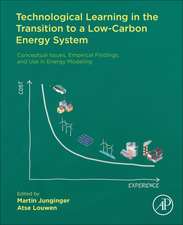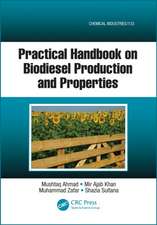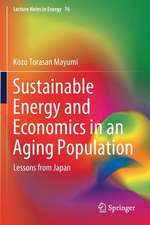Mobilisation of Forest Bioenergy in the Boreal and Temperate Biomes: Challenges, Opportunities and Case Studies
Editat de Evelyne Thiffault, C.T. Smith, Martin Junginger, Göran Berndesen Limba Engleză Paperback – 11 mai 2016
Efficiency and profitability of the supply chain are analyzed and the scale and level of confidence of feedstock inventory estimates are highlighted. Logistics and ecological and socio-economic footprints are also covered. This book provides a synthesis of the scientific and technical literature on specific aspects of forest biomass supply chains, and quantifies future potentials in comparison to estimates provided by other sources and the targets for bioenergy production set by various organizations (IEA, IPCC, etc.).
Finally, the book proposes recommendations for practitioners, policymakers, and future research. This approach makes the book especially relevant for professionals, policymakers, researchers, and graduate students in the field of bioenergy conversion and management, as well as those interested in sustainable management of natural resources.
- Presents foundational theory, examples and lessons learned, drawing on scientific and technical literature, as well as surveys conducted among stakeholders from various countries of the boreal and temperate biomes
- Provides best practices, insights, and recommendations through an integrative framework that encompasses various aspects of forest biomass supply chain, at different scales, and looking at a broad geographical and geopolitical range
- Compares contrasting history, policy context, and level of forest bioenergy development in several countries through several case studies
- Analyzes the efficiency and profitability of the supply chain, highlighting the scale and level of confidence of feedstock inventory estimates
Preț: 499.80 lei
Preț vechi: 549.23 lei
-9% Nou
Puncte Express: 750
Preț estimativ în valută:
95.67€ • 103.95$ • 80.41£
95.67€ • 103.95$ • 80.41£
Carte tipărită la comandă
Livrare economică 15-29 aprilie
Preluare comenzi: 021 569.72.76
Specificații
ISBN-13: 9780128045145
ISBN-10: 0128045140
Pagini: 266
Dimensiuni: 152 x 229 x 25 mm
Greutate: 1.11 kg
Editura: ELSEVIER SCIENCE
ISBN-10: 0128045140
Pagini: 266
Dimensiuni: 152 x 229 x 25 mm
Greutate: 1.11 kg
Editura: ELSEVIER SCIENCE
Cuprins
1. Introduction. Background, theoretical framework.
2. Models of forest biomass supply chains in various countries
3. Challenges and opportunities of logistics and economics of forest biomass mobilisation.
4. Social and economics aspects of forest biomass mobilisation.
5. Environmental sustainability aspects of forest biomass mobilisation, including soil, biodiversity, water and carbon balance.
6. Challenges and opportunities for the conversion technologies used to make forest biomass based bioenergy/biofuels
7. Challenges and opportunities of international trade of forest biomass
8. Forest bioenergy deployment in the absence of bioenergy policies/targets, with examples from Canada and Australia.
9. Quantifying forest biomass potential for mobilisation in the face of challenges and opportunities in the boreal and temperate biomes.
10. Conclusion: Synthesis and classification of main barriers and opportunities to mobilisation; comparisons and expectations of mobilisation of forest biomass in other biomes; recommendations.
2. Models of forest biomass supply chains in various countries
3. Challenges and opportunities of logistics and economics of forest biomass mobilisation.
4. Social and economics aspects of forest biomass mobilisation.
5. Environmental sustainability aspects of forest biomass mobilisation, including soil, biodiversity, water and carbon balance.
6. Challenges and opportunities for the conversion technologies used to make forest biomass based bioenergy/biofuels
7. Challenges and opportunities of international trade of forest biomass
8. Forest bioenergy deployment in the absence of bioenergy policies/targets, with examples from Canada and Australia.
9. Quantifying forest biomass potential for mobilisation in the face of challenges and opportunities in the boreal and temperate biomes.
10. Conclusion: Synthesis and classification of main barriers and opportunities to mobilisation; comparisons and expectations of mobilisation of forest biomass in other biomes; recommendations.






















